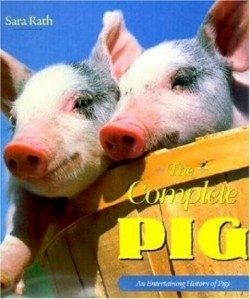The Complete Pig
Following in the successful hoofprints of The Complete Cow (1998), this latest animal compendium definitely brings home the bacon on pig legend, lore, and history from ancient to modern times. Those who are familiar with Rath’s work will immediately recognize her well-written, concise text which covers such topics as: the deeper meanings of nursery rhymes of old England; explanations of why pigs have been viewed through the centuries as symbols of both good and evil fortunes; wild boar; folktales and superstitions; characteristics of the various breeds; and pigs in literature and the entertainment industry.
These major subject areas are intriguing and fascinating and succeed in dispelling many of the myths still surrounding the pig. Upon reading the first chapter, one soon discovers that Mother Goose’s “This Little Pig Went to Market,” although innocent in its phrasing, was originally written in medieval times as an allegory about the Seven Deadly Sins. Thought to be extremely dirty or “unclean” by nature (likely a lazy farmer is the cause) and to hold evil spirits (much of this belief came from the Bible, where Jesus cast evil spirits into a herd of swine), pigs have been maligned in Western culture for centuries because of these beliefs. Not so in Asia, where pigs have been revered as symbols of good fortune for over 7,000 years and are honored as the twelfth sign in the Chinese lunar calendar. In Ancient Egypt, however, the pig was considered both good and evil; embodying the spirits of Egyptian gods Osiris and Seth while still considered too unclean to touch and believed to carry leprosy.
Much insight is given to the wild boar in the second chapter where Rath explains why and how the wild boar has been lauded—and hunted—throughout the ages. The third chapter, meanwhile, turns attention to the interesting folktales and superstitions of the pig and boar from around the world. Noted examples: Romans drank or washed in pig’s blood for purification, the Irish and Welsh believe a black pig is a bad sign, the Moors believed keeping a wild boar in the stables lured evil spirits away from the horses, while “in India pigs are sacrificed to the cholera goddess and disease demons.” Other superstitions describe how pigs have been associated with wealth or poverty, medicinal cures, and forecasting the weather, while another section is devoted to the roles pigs played in the lives of different saints.
For readers interested in the various breeds, the fourth chapter has details on the characteristics of the most common pedigrees of both pig and boar—including the meaning to various names applied to pigs such as shoat, barrow, and runner. Anyone searching for the lighter side of pigdom, however, need only check the last chapter to be entertained: literary examples are seen from Mother Goose rhymes and riddles to George Orwell’s Animal Farm. Pigs perform at the circus, on television and the big screen, and avid fans collect pig memorabilia. Also, a plethora of interesting tidbits—from pig colloquialisms and hog lingo to nursery rhymes, riddles, and quotes—are scattered throughout the text, lending an aura of whimsicality and fun amongst the somewhat more serious discussions of the main text.
Tying both text and tidbits together are the wonderful illustrations and beautiful photographs which—and anyone who sees this book will certainly agree—will be eagerly shared with friends and family. After all, pictures such as the cow that is wet nurse to piglets, racing pigs in action, and the chasing of a greased pig will not soon be forgotten. So, whether one just roots around in its myriad of pictures or goes hog wild in reading it cover-to-cover, The Complete Pig will bring squeals of laughter from both young and old.
Reviewed by
Nelly Heitman
Disclosure: This article is not an endorsement, but a review. The publisher of this book provided free copies of the book to have their book reviewed by a professional reviewer. No fee was paid by the publisher for this review. Foreword Reviews only recommends books that we love. Foreword Magazine, Inc. is disclosing this in accordance with the Federal Trade Commission’s 16 CFR, Part 255.

